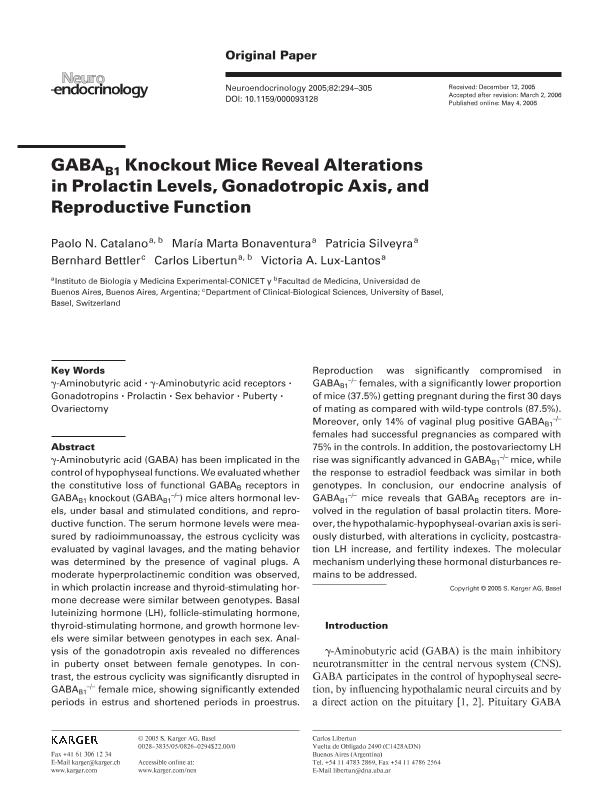Mostrar el registro sencillo del ítem
dc.contributor.author
Catalano, Paolo Nicolás

dc.contributor.author
Bonaventura, Maria Marta

dc.contributor.author
Silveyra, Patricia

dc.contributor.author
Bettler, Bernhard

dc.contributor.author
Libertun, Carlos

dc.contributor.author
Lux, Victoria Adela R.

dc.date.available
2017-12-22T05:27:03Z
dc.date.issued
2005-12
dc.identifier.citation
Lux, Victoria Adela R.; Libertun, Carlos; Bettler, Bernhard; Silveyra, Patricia; Bonaventura, Maria Marta; Catalano, Paolo Nicolás; et al.; GABAB1 knock-out mice reveals alteration in prolactin levels, gonadotropin axis and reproductive function; Karger; Neuroendocrinology; 82; 5-6; 12-2005; 294-305
dc.identifier.issn
0028-3835
dc.identifier.uri
http://hdl.handle.net/11336/31344
dc.description.abstract
gamma-Aminobutyric acid (GABA) has been implicated in the control of hypophyseal functions. We evaluated whether the constitutive loss of functional GABA(B) receptors in GABA(B1) knockout (GABA(B1)(-/-)) mice alters hormonal levels, under basal and stimulated conditions, and reproductive function. The serum hormone levels were measured by radioimmunoassay, the estrous cyclicity was evaluated by vaginal lavages, and the mating behavior was determined by the presence of vaginal plugs. A moderate hyperprolactinemic condition was observed, in which prolactin increase and thyroid-stimulating hormone decrease were similar between genotypes. Basal luteinizing hormone (LH), follicle-stimulating hormone, thyroid-stimulating hormone, and growth hormone levels were similar between genotypes in each sex. Analysis of the gonadotropin axis revealed no differences in puberty onset between female genotypes. In con trast, the estrous cyclicity was significantly disrupted in GABA(B1)(-/-) female mice, showing significantly extended periods in estrus and shortened periods in proestrus. Reproduction was significantly compromised in GABA(B1)(-/-) females, with a significantly lower proportion of mice (37.5%) getting pregnant during the first 30 days of mating as compared with wild-type controls (87.5%). Moreover, only 14% of vaginal plug positive GABA(B1)(-/-) females had successful pregnancies as compared with 75% in the controls. In addition, the postovariectomy LH rise was significantly advanced in GABA(B1)(-/-) mice, while the response to estradiol feedback was similar in both genotypes. In conclusion, our endocrine analysis of GABA(B1)(-/-) mice reveals that GABA(B) receptors are involved in the regulation of basal prolactin titers. Moreover, the hypothalamic-hypophyseal-ovarian axis is seriously disturbed, with alterations in cyclicity, postcastration LH increase, and fertility indexes. The molecular mechanism underlying these hormonal disturbances remains to be addressed.
dc.format
application/pdf
dc.language.iso
eng
dc.publisher
Karger

dc.rights
info:eu-repo/semantics/openAccess
dc.rights.uri
https://creativecommons.org/licenses/by-nc-sa/2.5/ar/
dc.subject
Estradiol
dc.subject
Growth Hormone
dc.subject
Pituitary Gland
dc.subject
Testis
dc.subject
Reproduction Physiology
dc.subject.classification
Neurociencias

dc.subject.classification
Medicina Básica

dc.subject.classification
CIENCIAS MÉDICAS Y DE LA SALUD

dc.subject.classification
Biología Reproductiva

dc.subject.classification
Ciencias Biológicas

dc.subject.classification
CIENCIAS NATURALES Y EXACTAS

dc.title
GABAB1 knock-out mice reveals alteration in prolactin levels, gonadotropin axis and reproductive function
dc.type
info:eu-repo/semantics/article
dc.type
info:ar-repo/semantics/artículo
dc.type
info:eu-repo/semantics/publishedVersion
dc.date.updated
2017-12-19T18:36:46Z
dc.identifier.eissn
1423-0194
dc.journal.volume
82
dc.journal.number
5-6
dc.journal.pagination
294-305
dc.journal.pais
Suiza

dc.journal.ciudad
Basel
dc.description.fil
Fil: Catalano, Paolo Nicolás. Consejo Nacional de Investigaciones Científicas y Técnicas. Instituto de Biología y Medicina Experimental. Fundación de Instituto de Biología y Medicina Experimental. Instituto de Biología y Medicina Experimental; Argentina. Universidad de Buenos Aires. Facultad de Medicina; Argentina
dc.description.fil
Fil: Bonaventura, Maria Marta. Consejo Nacional de Investigaciones Científicas y Técnicas. Instituto de Biología y Medicina Experimental. Fundación de Instituto de Biología y Medicina Experimental. Instituto de Biología y Medicina Experimental; Argentina
dc.description.fil
Fil: Silveyra, Patricia. Consejo Nacional de Investigaciones Científicas y Técnicas. Instituto de Biología y Medicina Experimental. Fundación de Instituto de Biología y Medicina Experimental. Instituto de Biología y Medicina Experimental; Argentina
dc.description.fil
Fil: Bettler, Bernhard. University of Basel; Suiza
dc.description.fil
Fil: Libertun, Carlos. Consejo Nacional de Investigaciones Científicas y Técnicas. Instituto de Biología y Medicina Experimental. Fundación de Instituto de Biología y Medicina Experimental. Instituto de Biología y Medicina Experimental; Argentina. Universidad de Buenos Aires. Facultad de Medicina; Argentina
dc.description.fil
Fil: Lux, Victoria Adela R.. Consejo Nacional de Investigaciones Científicas y Técnicas. Instituto de Biología y Medicina Experimental. Fundación de Instituto de Biología y Medicina Experimental. Instituto de Biología y Medicina Experimental; Argentina
dc.journal.title
Neuroendocrinology

dc.relation.alternativeid
info:eu-repo/semantics/altIdentifier/url/https://www.karger.com/Article/Abstract/93128
dc.relation.alternativeid
info:eu-repo/semantics/altIdentifier/doi/http://dx.doi.org/10.1159/000093128
dc.relation.alternativeid
info:eu-repo/semantics/altIdentifier/pmid/https://www.ncbi.nlm.nih.gov/pubmed/16682806
Archivos asociados
